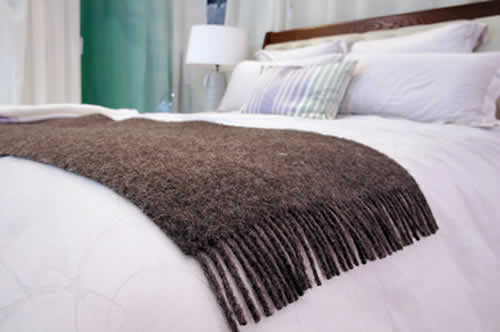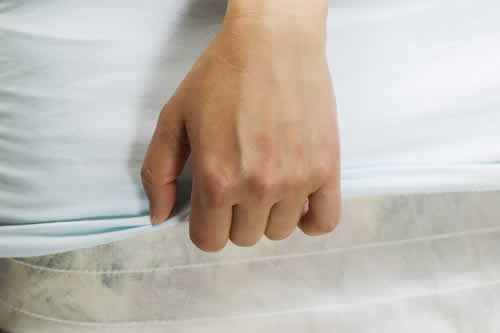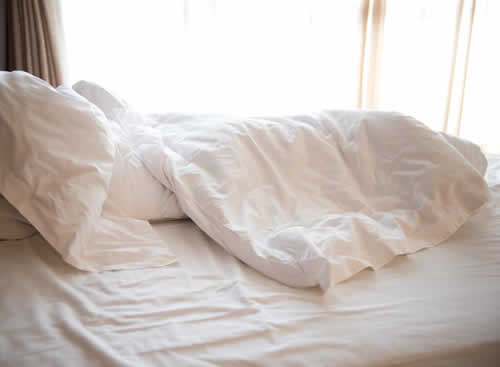Positive Health Online
Your Country

When is it Time to Replace your Mattress?
listed in sleep and insomnia, originally published in issue 217 - October 2014
We spend roughly one third of their lives in bed, so it’s no surprise that the quality of the bed can affect both the sleeper’s health and happiness. Yet, although mattresses are used every day and are arguably one of the most used and most important pieces of furniture in the home, it’s easy to forget about them and go long periods of time without checking if they are still in good condition. Below are some top tips on how to check the quality of a mattress and determine whether or not it needs replacing.

How Old is It?
Mattresses don’t have a traditional ‘best before date’, but five years is the recommended length of time to keep a mattress. However, not all mattresses will last the five years and if the mattress begins to show signs of wear and tear it may be time to replace it already, rather than holding out for five years when it’s going to be completely ruined and useless. Some mattresses, particularly high quality ones, have been known to easily exceed the five year guideline, but this remains a good life cycle benchmark.
How Does it Look?
There are a few things to look out for; does it look old? Is it misshapen? Are there sags and bumps where people sleep? Check for signs of visible wear and tear, particularly along the ‘line’ of the edges and corners. A low quality mattress will begin to show ‘worn’ signs long before a high-quality mattress will, and will need replacing more often.

How does it Feel?
There should be a consistently high level of support throughout the entire mattress. This can be tested by feeling across the top of the mattress, as well as pushing down on various areas of the mattress to check the level of resistance. The mattress needs to feel slightly like it’s pushing back against you in order to correctly support your body and ensure you get a good night’s sleep, as well as preventing any unnecessary aches and pains the following day.

How are you Sleeping?
Sleep is instrumental to a person’s wellbeing, allowing the body to recover from what it has been through during the day as well as keeping illnesses at bay. A low-quality mattress may compromise the quality of sleep and possibly make it much more difficult to get to sleep and wake up feeling refreshed. Consider how hard it has been to get to sleep or get out of bed in the morning, including how many times it’s been difficult to find a comfortable position for sleeping, over the past fortnight.
How does it Compare?
A good way to determine the quality of a mattress is to compare it to one that isn’t your own; whether travelling for business or a holiday, when using a different bed for the night it’s a good idea to compare your night of sleep to the one you would usually have in your own bed at home. It’s normal to have a worse night’s sleep when away from home, due to the unfamiliar surroundings and lack of home comforts. If the night’s sleep is better away than at home, however, it may be down to the quality and age of the mattress.
It’s important to bear in mind the initial quality of the mattress when it was purchased; some mattresses may only last a couple of years, whilst some will last five years of even more, simply because all mattresses vary in size, quality and how often they’re used. Mattresses that are used seven days a week will deteriorate much quicker than a bed that is only used for a few nights a week; however a high-quality mattress that is used for the whole seven nights still has the potential to out-live a low-quality mattress that is only used for a few days a week. Once the conscious decision has been made to purchase a new mattress, the shopper is then faced by many aspects to take into consideration when making their choice.
Personal Needs
There are two key aspects to avoid when looking for a new mattress, which are often the most relied upon by unsuspecting customers; the sales person in the store and how the mattress may feel in the few seconds it’s tested. A sales person may simply want to sell the most expensive products in the shop, or those they get commission on, and are unlikely to truly have the customer’s preferences in mind.
Bouncing or lying on a mattress for a few seconds also isn’t the best idea, as people become accustomed to the mattress they have at home, even if it isn’t working for them any longer, and if it’s time for the mattress to be replaced, they’ll be accustomed to a lower quality than what they need. Key questions to think about before purchasing a mattress are: if sharing the bed, do both people have different needs, with regards to materials, firmness and so on? Are any areas of the body considered to be ‘problem areas’ that need a little more support? And obviously, what size is required to fit the bed?
If you have made the decision to purchase a new mattress, the below is the size guide of mattresses available;
- Single: 90cm x 90cm;
- Double: 135cm x 190cm;
- Euro (Ikea) Double: 140cm x 200cm;
- King: 150cm x 200cm;
- Euro King: 160cm x 200cm;
- Super King: 180cm x 200cm.
Types and Materials
There are many different types of mattresses on the market:
- Springs; bonnell coils, open coils, pocket springs, plastic springs and fibreglass springs encapsulated in moulded latex or memory foam;
- Foams; closed-cell high resilience impact polyurethene foam, visco-elastic memory foam, green foam, latex foam and synthetic;
- Latex;
- Gel-infused memory foam;
- Gel sheets;
- Coir;
- Wadding;
- Horse hair;
- Wool;
- WaterAir;
- 3D airflow mesh.
It can be tricky to know where to start when it comes to mattress types and materials, but it’s definitely recommended that a little research is undertaken before a purchase is made. It’s always worth noting that sometimes it’s good to have a change and choose a mattress that is a different type to the previous one.
Performance Ratings
There are various ways to determine the performance of a mattress: ILD, density and pocket spring count and spring gauge:
- ILD, or Indentation Load Deflection, is the standard rating procedure that depicts the firmness of the foam within a memory mattress. For example, a low ILD rating, 8lbs or lower, would suggest a very soft surface, whereas 20lbs would suggest a very firm foam that requires more weight to depress;
- The density rating only determines the density of the memory foam and no other part of the mattress. The density of the foam can have an effect on how it supports the person using it, as well as the overall lifespan of the mattress. The preference is a higher density as it tends to indicate a quality material that will last longer, however many low-quality mattresses will have a low density rating;
- The spring count typically tells you how many springs are used within sprung mattress, therefore the more there are, the firmer the mattress typically is. This is one of the best ways to determine whether a mattress is low or high quality; any mattress with a spring count of up to 600 is considered low quality, any mattress with a spring count between 600 and 2000 is either considered good quality or high quality.
- Alongside the spring count, it’s important to check the spring gauge which depicts how well the springs perform with regards to firmness and durability. On average these vary between 12 and 18, with the firmer mattress have a lower number.
Covers, Tickings and Finishes
Most people don’t consider the cover of the mattress, also known as ticking, which is a specifically durable weave finish on the mattress. Whilst this may not have an effect on sleep and support, it can affect how comfortable the mattress is to sleep on.
There are numerous covers, tickings and finishes available on the market: rayon, tencel, polyester, cotton, damask, bamboo, lyocell, viscose, lycra, elastane, organic cotton, blends, wool, coolmax, outlast, climasmart and cairfull. As for the type and material of a mattress, research is always recommended to determine which mattress will best suit the sleeper.
Aftercare and Maintenance
Whether purchasing a low or high-quality mattress, it’s still going to incur the shopper a substantial outgoing and therefore, in order to get the most out of the mattress, it needs to be maintained.
Certain types of sprung mattresses need turning; rotating the mattress every couple of months avoids placing repeated stress on the springs for a prolonged period of time. Not only will this increase the lifespan of the mattress, but it will also provide support from springs that haven’t yet been used. In order to restrict dreaded bed bugs and dust mites, the mattress and bed will require regular hoovering; as well as the sheets needing to be changed on a regular basis.
With regards to bedding, using a sheet, duvet and pillows simply isn’t enough. In order to prolong the life of the mattress, as well as the pillows, it’s possible to purchase mattress and pillow protectors - these are similar to sheets and pillow cases, but made of specialized material in order provide an additional barrier between yourself and the mattress.
The above points are simply for guidance and will not apply to every mattress or every sleeper. For example, a memory foam mattress will greatly differ from a pocket sprung mattress, whilst at the same time a low-quality mattress purporting to be ‘memory foam’ will actually consist of a single block of low-quality foam that doesn’t have any of the performance properties of memory foam, whilst a high-quality memory foam mattress will have so much more to it. Alongside this, prices can be misleading with high cost not always meaning high quality, and then when you take into consideration the material quality, performance and longevity, all of this can make it tricky to choose the correct mattress. As a rule of thumb, these tips should help in the decision and identify which mattress will aid in providing the best night’s sleep.
Comments:
-
No Article Comments available